An Analysis of Indian Economy
VerifiedAdded on 2023/01/09
|11
|2782
|71
AI Summary
This report analyzes the economy of India, including its background, current challenges, and recommendations for improvement. It also discusses the conflicts between Indian political and economic ideologies.
Contribute Materials
Your contribution can guide someone’s learning journey. Share your
documents today.
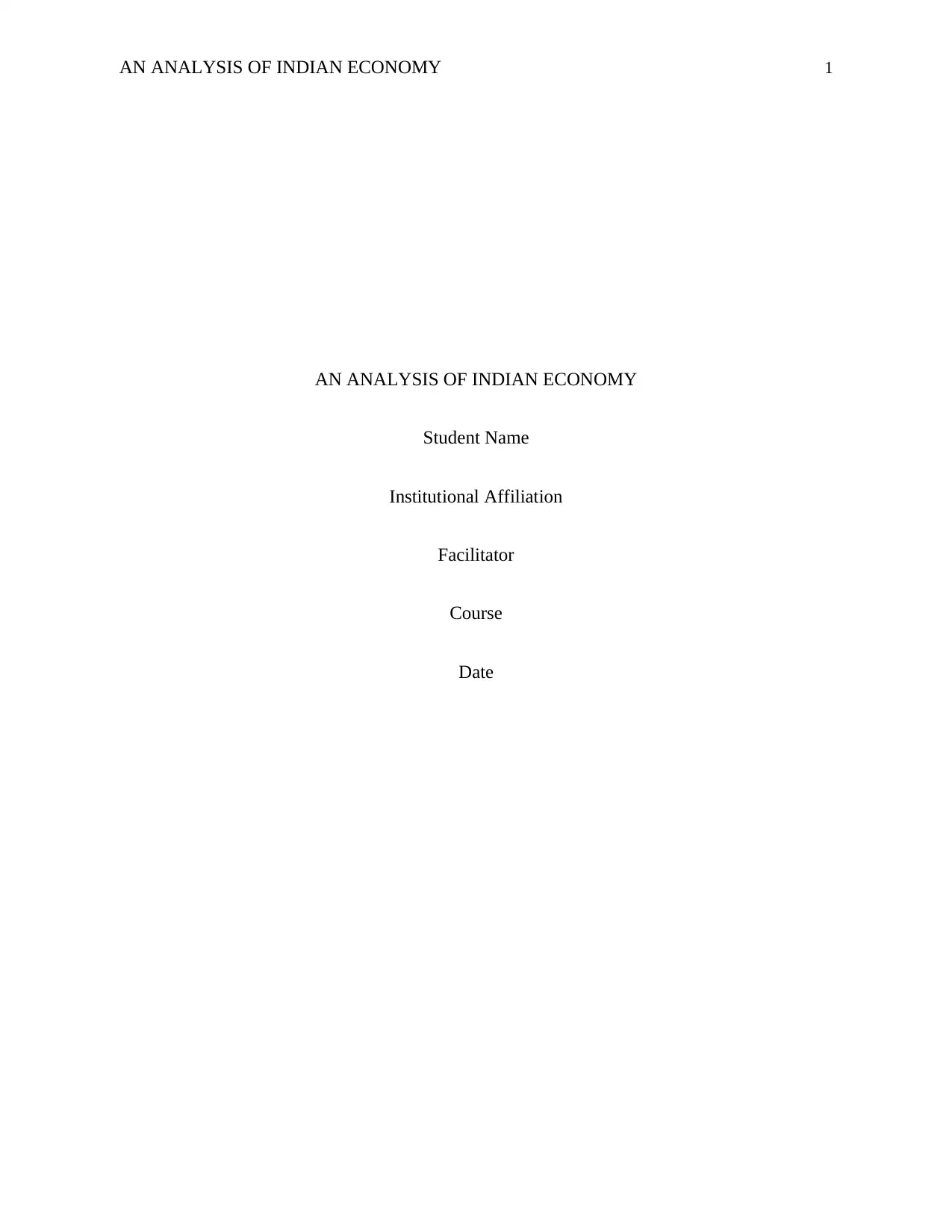
AN ANALYSIS OF INDIAN ECONOMY 1
AN ANALYSIS OF INDIAN ECONOMY
Student Name
Institutional Affiliation
Facilitator
Course
Date
AN ANALYSIS OF INDIAN ECONOMY
Student Name
Institutional Affiliation
Facilitator
Course
Date
Secure Best Marks with AI Grader
Need help grading? Try our AI Grader for instant feedback on your assignments.
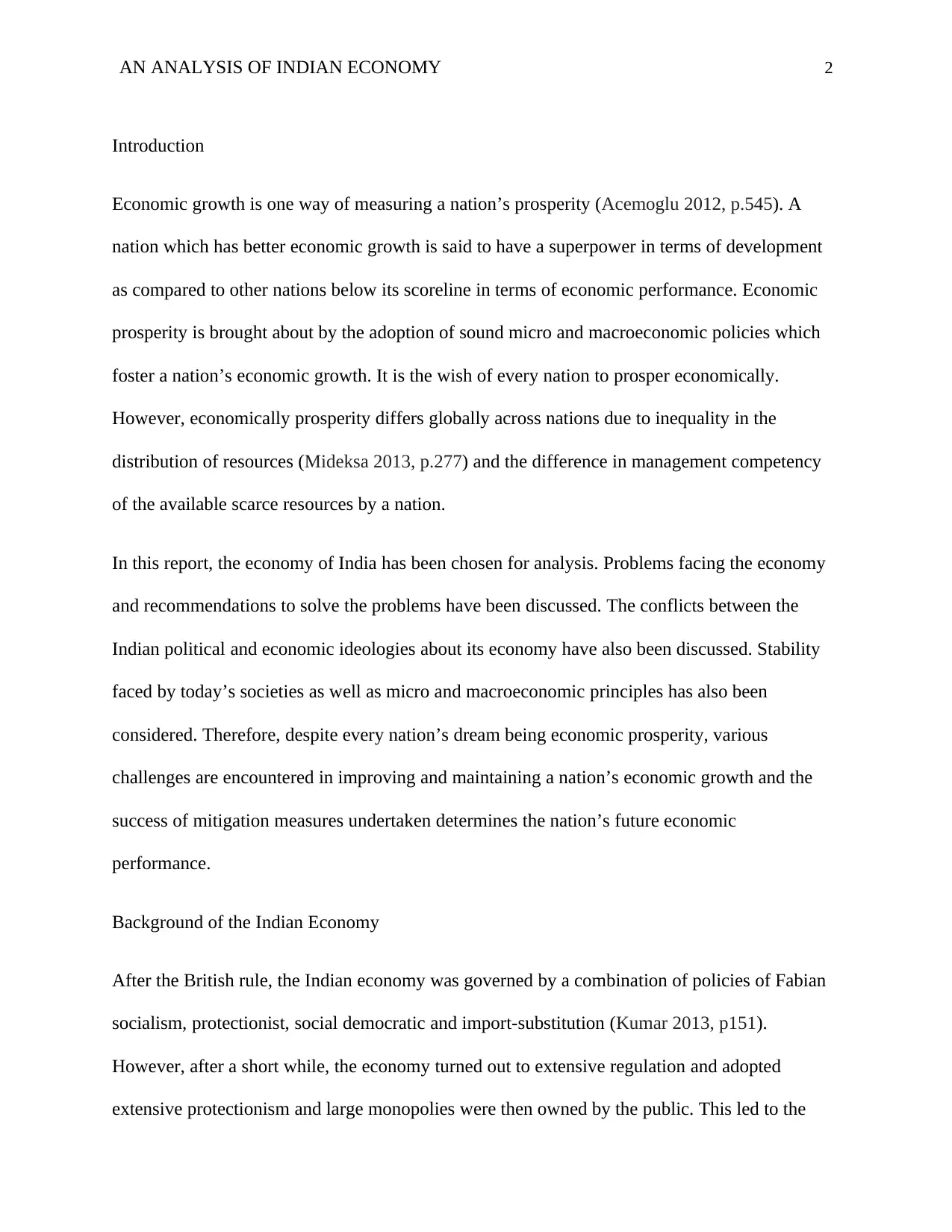
AN ANALYSIS OF INDIAN ECONOMY 2
Introduction
Economic growth is one way of measuring a nation’s prosperity (Acemoglu 2012, p.545). A
nation which has better economic growth is said to have a superpower in terms of development
as compared to other nations below its scoreline in terms of economic performance. Economic
prosperity is brought about by the adoption of sound micro and macroeconomic policies which
foster a nation’s economic growth. It is the wish of every nation to prosper economically.
However, economically prosperity differs globally across nations due to inequality in the
distribution of resources (Mideksa 2013, p.277) and the difference in management competency
of the available scarce resources by a nation.
In this report, the economy of India has been chosen for analysis. Problems facing the economy
and recommendations to solve the problems have been discussed. The conflicts between the
Indian political and economic ideologies about its economy have also been discussed. Stability
faced by today’s societies as well as micro and macroeconomic principles has also been
considered. Therefore, despite every nation’s dream being economic prosperity, various
challenges are encountered in improving and maintaining a nation’s economic growth and the
success of mitigation measures undertaken determines the nation’s future economic
performance.
Background of the Indian Economy
After the British rule, the Indian economy was governed by a combination of policies of Fabian
socialism, protectionist, social democratic and import-substitution (Kumar 2013, p151).
However, after a short while, the economy turned out to extensive regulation and adopted
extensive protectionism and large monopolies were then owned by the public. This led to the
Introduction
Economic growth is one way of measuring a nation’s prosperity (Acemoglu 2012, p.545). A
nation which has better economic growth is said to have a superpower in terms of development
as compared to other nations below its scoreline in terms of economic performance. Economic
prosperity is brought about by the adoption of sound micro and macroeconomic policies which
foster a nation’s economic growth. It is the wish of every nation to prosper economically.
However, economically prosperity differs globally across nations due to inequality in the
distribution of resources (Mideksa 2013, p.277) and the difference in management competency
of the available scarce resources by a nation.
In this report, the economy of India has been chosen for analysis. Problems facing the economy
and recommendations to solve the problems have been discussed. The conflicts between the
Indian political and economic ideologies about its economy have also been discussed. Stability
faced by today’s societies as well as micro and macroeconomic principles has also been
considered. Therefore, despite every nation’s dream being economic prosperity, various
challenges are encountered in improving and maintaining a nation’s economic growth and the
success of mitigation measures undertaken determines the nation’s future economic
performance.
Background of the Indian Economy
After the British rule, the Indian economy was governed by a combination of policies of Fabian
socialism, protectionist, social democratic and import-substitution (Kumar 2013, p151).
However, after a short while, the economy turned out to extensive regulation and adopted
extensive protectionism and large monopolies were then owned by the public. This led to the

AN ANALYSIS OF INDIAN ECONOMY 3
nation’s sluggish economic growth at the early stages. Since the year 1991, the nation’s
economic liberation has enabled it to shift to a market-based economy hence improving its
economic growth.
Currently, India has a developing mixed economy. The nation has improved its trade freedom
and according to the 2019 Index, it is ranked position 129 with a score of 55.2 in terms of
economic freedom. This is an increment of 0.7 points due to improvement in India’s efficiency
of its judiciary which has highly improved government integrity. Economic liberation has
enabled India to maintain its economic growth which is measured by the gross domestic product
at an average of 6-7 percent. Its unemployment rate is low at the rate of 3.5 percent while
inflation is slightly higher at 3.6 percent. It has therefore been ranked among the fastest growing
economies in the world and has even surpassed China in terms of economic growth. In the Asia-
Pacific region, India is ranked position 31 out of the 43 nations in the region in terms of
economic performance. Its performance is below the expected averages at both the regional and
world levels an indication that still much needs to be done to improve the nation’s economy to a
world-class level. In terms of the nominal gross domestic product, India is ranked position seven
and position 3 in terms of purchasing power parity in the world. India is anticipated to improve
its economic performance in future as its service industry is growing at a fast pace making the
nation the world’s major export of information technology services, soft services, and Business
Process Outsourcing services.
Modern Society Economic Stability
Economic stability is reflected by the nation’s ability to minimize fluctuations in its economic
output by maintaining the stability of its micro and macroeconomic indicators. A stable economy
nation’s sluggish economic growth at the early stages. Since the year 1991, the nation’s
economic liberation has enabled it to shift to a market-based economy hence improving its
economic growth.
Currently, India has a developing mixed economy. The nation has improved its trade freedom
and according to the 2019 Index, it is ranked position 129 with a score of 55.2 in terms of
economic freedom. This is an increment of 0.7 points due to improvement in India’s efficiency
of its judiciary which has highly improved government integrity. Economic liberation has
enabled India to maintain its economic growth which is measured by the gross domestic product
at an average of 6-7 percent. Its unemployment rate is low at the rate of 3.5 percent while
inflation is slightly higher at 3.6 percent. It has therefore been ranked among the fastest growing
economies in the world and has even surpassed China in terms of economic growth. In the Asia-
Pacific region, India is ranked position 31 out of the 43 nations in the region in terms of
economic performance. Its performance is below the expected averages at both the regional and
world levels an indication that still much needs to be done to improve the nation’s economy to a
world-class level. In terms of the nominal gross domestic product, India is ranked position seven
and position 3 in terms of purchasing power parity in the world. India is anticipated to improve
its economic performance in future as its service industry is growing at a fast pace making the
nation the world’s major export of information technology services, soft services, and Business
Process Outsourcing services.
Modern Society Economic Stability
Economic stability is reflected by the nation’s ability to minimize fluctuations in its economic
output by maintaining the stability of its micro and macroeconomic indicators. A stable economy

AN ANALYSIS OF INDIAN ECONOMY 4
improves the nation’s economic growth as investors and businesses within the nation expand
their productivity and foreign direct investments increase due to the nation’s stability.
Today’s modern society is experiencing a relatively stable economy. This has been brought
about by globalization which has enabled many nations to venture into international trade due to
its vast merits. Fragilities related to the crisis that occurred during the past decade have been
decreasing gradually restoring global economic stability. The world economy has improved from
the year 2016 to 2018 from 2.4 percent economic growth rate to 3.0 percent due to the stability
of market exchange rates and the improvement of the purchasing power parities.
However, economic stability in modern society is unevenly distributed across nations. In the
modern society, the developed nations such as the United States and nations in the East and
South Asia are experiencing highly stable economies while the developing and underdeveloped
countries are experiencing relatively low stable economies such as many African nations. It’s
worth concluding that modern society is experiencing a stable economy as nations strive to
improve their economic performance to world levels and hence work towards maintaining their
economies stable to expand the productivity of their economies.
Micro and Macroeconomic Principles
A nation’s economy is categorized into two sectors namely the microeconomic macroeconomic
sectors. Principles formulated by either sector affect the other and hence are interdependent and
act as a compliment to each other.
Microeconomic principles are applied by individuals and businesses in making crucial decisions
on how to efficiently allocate the available scarce resources and price their goods and services to
improves the nation’s economic growth as investors and businesses within the nation expand
their productivity and foreign direct investments increase due to the nation’s stability.
Today’s modern society is experiencing a relatively stable economy. This has been brought
about by globalization which has enabled many nations to venture into international trade due to
its vast merits. Fragilities related to the crisis that occurred during the past decade have been
decreasing gradually restoring global economic stability. The world economy has improved from
the year 2016 to 2018 from 2.4 percent economic growth rate to 3.0 percent due to the stability
of market exchange rates and the improvement of the purchasing power parities.
However, economic stability in modern society is unevenly distributed across nations. In the
modern society, the developed nations such as the United States and nations in the East and
South Asia are experiencing highly stable economies while the developing and underdeveloped
countries are experiencing relatively low stable economies such as many African nations. It’s
worth concluding that modern society is experiencing a stable economy as nations strive to
improve their economic performance to world levels and hence work towards maintaining their
economies stable to expand the productivity of their economies.
Micro and Macroeconomic Principles
A nation’s economy is categorized into two sectors namely the microeconomic macroeconomic
sectors. Principles formulated by either sector affect the other and hence are interdependent and
act as a compliment to each other.
Microeconomic principles are applied by individuals and businesses in making crucial decisions
on how to efficiently allocate the available scarce resources and price their goods and services to
Paraphrase This Document
Need a fresh take? Get an instant paraphrase of this document with our AI Paraphraser
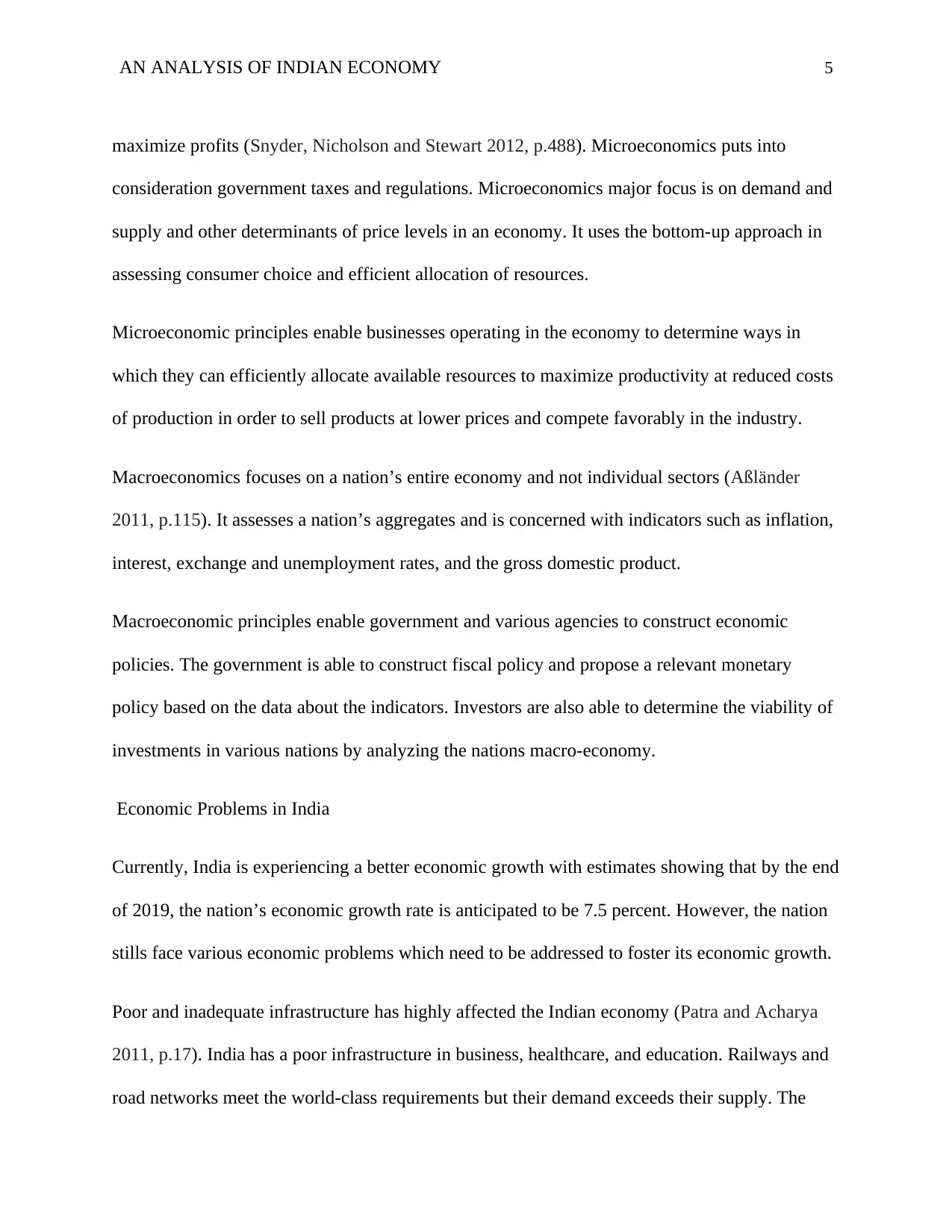
AN ANALYSIS OF INDIAN ECONOMY 5
maximize profits (Snyder, Nicholson and Stewart 2012, p.488). Microeconomics puts into
consideration government taxes and regulations. Microeconomics major focus is on demand and
supply and other determinants of price levels in an economy. It uses the bottom-up approach in
assessing consumer choice and efficient allocation of resources.
Microeconomic principles enable businesses operating in the economy to determine ways in
which they can efficiently allocate available resources to maximize productivity at reduced costs
of production in order to sell products at lower prices and compete favorably in the industry.
Macroeconomics focuses on a nation’s entire economy and not individual sectors (Aßländer
2011, p.115). It assesses a nation’s aggregates and is concerned with indicators such as inflation,
interest, exchange and unemployment rates, and the gross domestic product.
Macroeconomic principles enable government and various agencies to construct economic
policies. The government is able to construct fiscal policy and propose a relevant monetary
policy based on the data about the indicators. Investors are also able to determine the viability of
investments in various nations by analyzing the nations macro-economy.
Economic Problems in India
Currently, India is experiencing a better economic growth with estimates showing that by the end
of 2019, the nation’s economic growth rate is anticipated to be 7.5 percent. However, the nation
stills face various economic problems which need to be addressed to foster its economic growth.
Poor and inadequate infrastructure has highly affected the Indian economy (Patra and Acharya
2011, p.17). India has a poor infrastructure in business, healthcare, and education. Railways and
road networks meet the world-class requirements but their demand exceeds their supply. The
maximize profits (Snyder, Nicholson and Stewart 2012, p.488). Microeconomics puts into
consideration government taxes and regulations. Microeconomics major focus is on demand and
supply and other determinants of price levels in an economy. It uses the bottom-up approach in
assessing consumer choice and efficient allocation of resources.
Microeconomic principles enable businesses operating in the economy to determine ways in
which they can efficiently allocate available resources to maximize productivity at reduced costs
of production in order to sell products at lower prices and compete favorably in the industry.
Macroeconomics focuses on a nation’s entire economy and not individual sectors (Aßländer
2011, p.115). It assesses a nation’s aggregates and is concerned with indicators such as inflation,
interest, exchange and unemployment rates, and the gross domestic product.
Macroeconomic principles enable government and various agencies to construct economic
policies. The government is able to construct fiscal policy and propose a relevant monetary
policy based on the data about the indicators. Investors are also able to determine the viability of
investments in various nations by analyzing the nations macro-economy.
Economic Problems in India
Currently, India is experiencing a better economic growth with estimates showing that by the end
of 2019, the nation’s economic growth rate is anticipated to be 7.5 percent. However, the nation
stills face various economic problems which need to be addressed to foster its economic growth.
Poor and inadequate infrastructure has highly affected the Indian economy (Patra and Acharya
2011, p.17). India has a poor infrastructure in business, healthcare, and education. Railways and
road networks meet the world-class requirements but their demand exceeds their supply. The
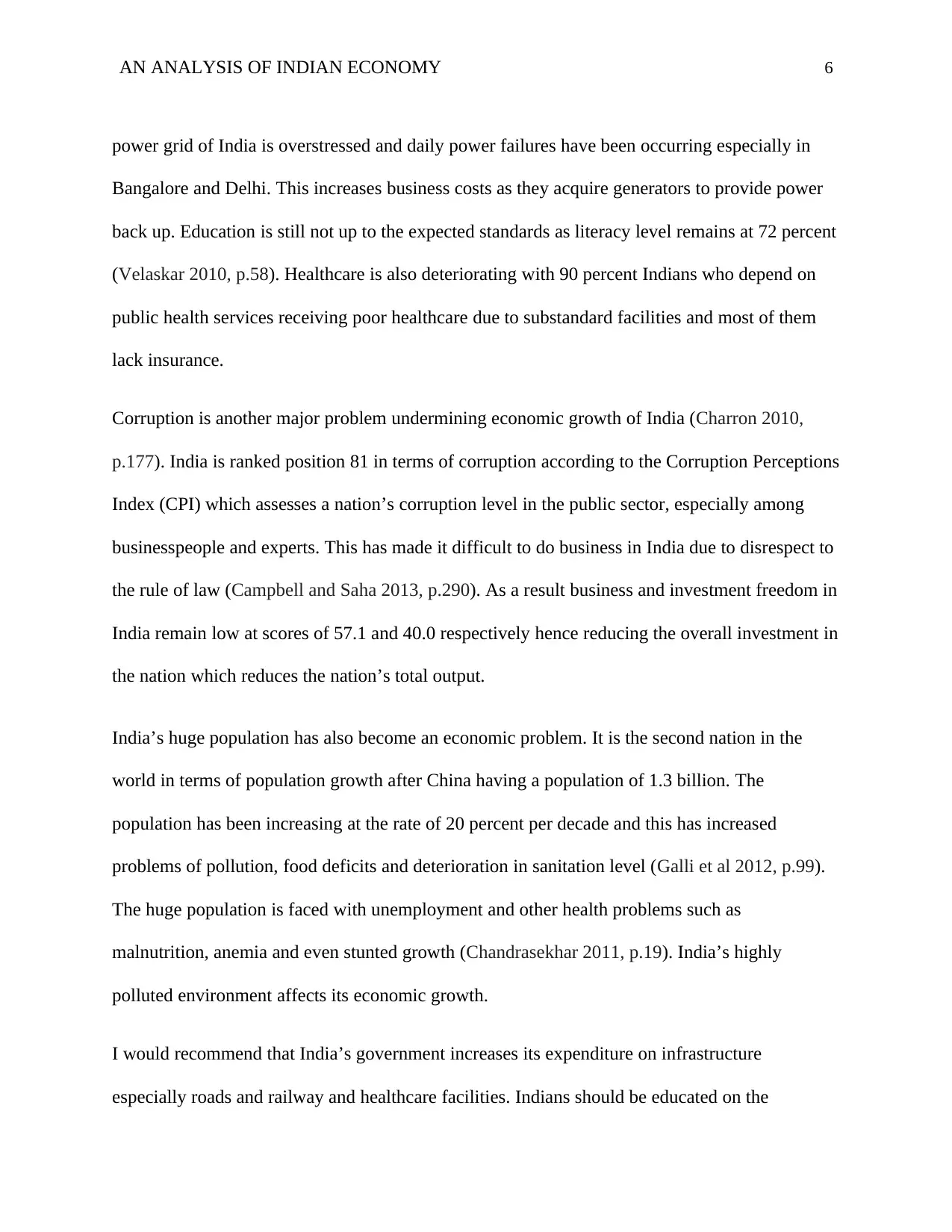
AN ANALYSIS OF INDIAN ECONOMY 6
power grid of India is overstressed and daily power failures have been occurring especially in
Bangalore and Delhi. This increases business costs as they acquire generators to provide power
back up. Education is still not up to the expected standards as literacy level remains at 72 percent
(Velaskar 2010, p.58). Healthcare is also deteriorating with 90 percent Indians who depend on
public health services receiving poor healthcare due to substandard facilities and most of them
lack insurance.
Corruption is another major problem undermining economic growth of India (Charron 2010,
p.177). India is ranked position 81 in terms of corruption according to the Corruption Perceptions
Index (CPI) which assesses a nation’s corruption level in the public sector, especially among
businesspeople and experts. This has made it difficult to do business in India due to disrespect to
the rule of law (Campbell and Saha 2013, p.290). As a result business and investment freedom in
India remain low at scores of 57.1 and 40.0 respectively hence reducing the overall investment in
the nation which reduces the nation’s total output.
India’s huge population has also become an economic problem. It is the second nation in the
world in terms of population growth after China having a population of 1.3 billion. The
population has been increasing at the rate of 20 percent per decade and this has increased
problems of pollution, food deficits and deterioration in sanitation level (Galli et al 2012, p.99).
The huge population is faced with unemployment and other health problems such as
malnutrition, anemia and even stunted growth (Chandrasekhar 2011, p.19). India’s highly
polluted environment affects its economic growth.
I would recommend that India’s government increases its expenditure on infrastructure
especially roads and railway and healthcare facilities. Indians should be educated on the
power grid of India is overstressed and daily power failures have been occurring especially in
Bangalore and Delhi. This increases business costs as they acquire generators to provide power
back up. Education is still not up to the expected standards as literacy level remains at 72 percent
(Velaskar 2010, p.58). Healthcare is also deteriorating with 90 percent Indians who depend on
public health services receiving poor healthcare due to substandard facilities and most of them
lack insurance.
Corruption is another major problem undermining economic growth of India (Charron 2010,
p.177). India is ranked position 81 in terms of corruption according to the Corruption Perceptions
Index (CPI) which assesses a nation’s corruption level in the public sector, especially among
businesspeople and experts. This has made it difficult to do business in India due to disrespect to
the rule of law (Campbell and Saha 2013, p.290). As a result business and investment freedom in
India remain low at scores of 57.1 and 40.0 respectively hence reducing the overall investment in
the nation which reduces the nation’s total output.
India’s huge population has also become an economic problem. It is the second nation in the
world in terms of population growth after China having a population of 1.3 billion. The
population has been increasing at the rate of 20 percent per decade and this has increased
problems of pollution, food deficits and deterioration in sanitation level (Galli et al 2012, p.99).
The huge population is faced with unemployment and other health problems such as
malnutrition, anemia and even stunted growth (Chandrasekhar 2011, p.19). India’s highly
polluted environment affects its economic growth.
I would recommend that India’s government increases its expenditure on infrastructure
especially roads and railway and healthcare facilities. Indians should be educated on the
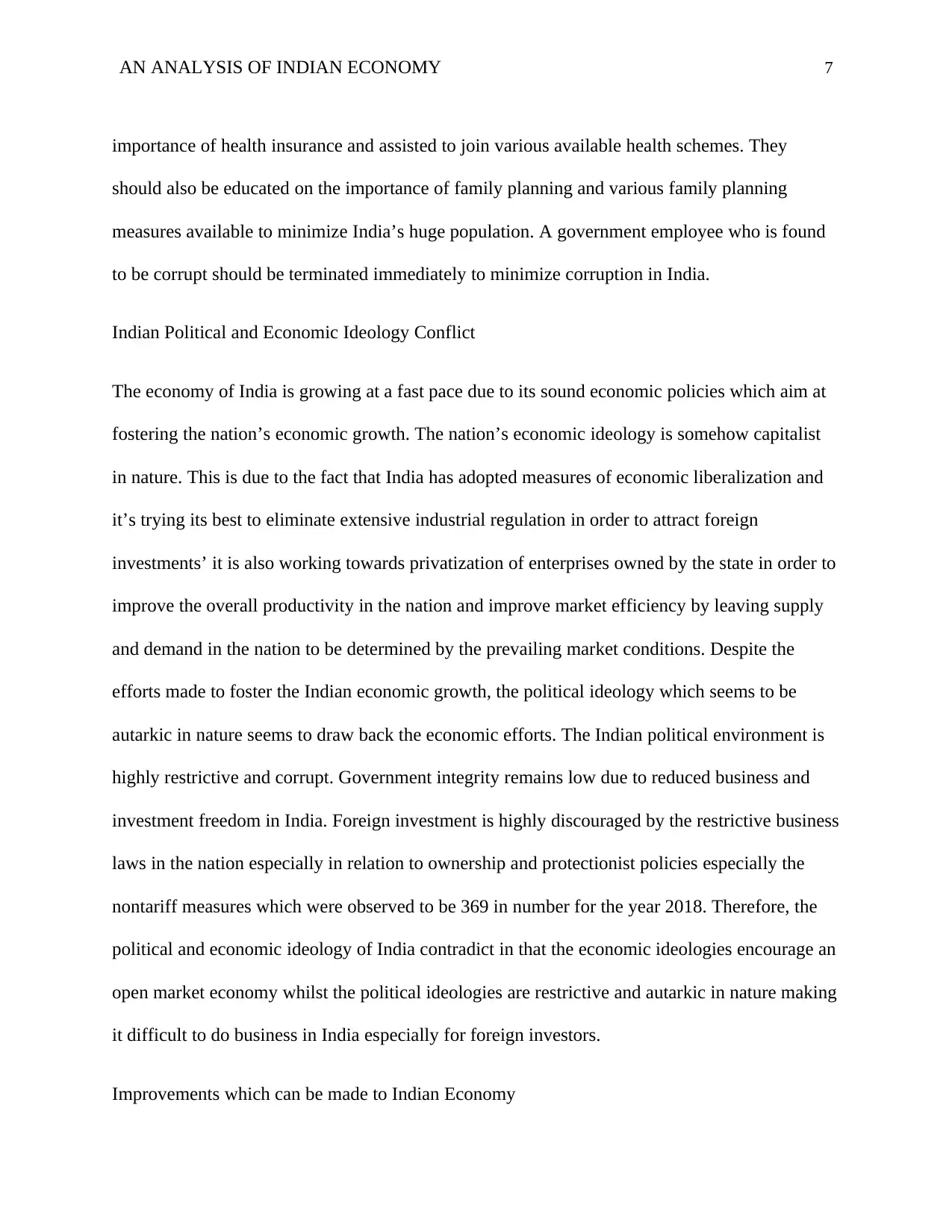
AN ANALYSIS OF INDIAN ECONOMY 7
importance of health insurance and assisted to join various available health schemes. They
should also be educated on the importance of family planning and various family planning
measures available to minimize India’s huge population. A government employee who is found
to be corrupt should be terminated immediately to minimize corruption in India.
Indian Political and Economic Ideology Conflict
The economy of India is growing at a fast pace due to its sound economic policies which aim at
fostering the nation’s economic growth. The nation’s economic ideology is somehow capitalist
in nature. This is due to the fact that India has adopted measures of economic liberalization and
it’s trying its best to eliminate extensive industrial regulation in order to attract foreign
investments’ it is also working towards privatization of enterprises owned by the state in order to
improve the overall productivity in the nation and improve market efficiency by leaving supply
and demand in the nation to be determined by the prevailing market conditions. Despite the
efforts made to foster the Indian economic growth, the political ideology which seems to be
autarkic in nature seems to draw back the economic efforts. The Indian political environment is
highly restrictive and corrupt. Government integrity remains low due to reduced business and
investment freedom in India. Foreign investment is highly discouraged by the restrictive business
laws in the nation especially in relation to ownership and protectionist policies especially the
nontariff measures which were observed to be 369 in number for the year 2018. Therefore, the
political and economic ideology of India contradict in that the economic ideologies encourage an
open market economy whilst the political ideologies are restrictive and autarkic in nature making
it difficult to do business in India especially for foreign investors.
Improvements which can be made to Indian Economy
importance of health insurance and assisted to join various available health schemes. They
should also be educated on the importance of family planning and various family planning
measures available to minimize India’s huge population. A government employee who is found
to be corrupt should be terminated immediately to minimize corruption in India.
Indian Political and Economic Ideology Conflict
The economy of India is growing at a fast pace due to its sound economic policies which aim at
fostering the nation’s economic growth. The nation’s economic ideology is somehow capitalist
in nature. This is due to the fact that India has adopted measures of economic liberalization and
it’s trying its best to eliminate extensive industrial regulation in order to attract foreign
investments’ it is also working towards privatization of enterprises owned by the state in order to
improve the overall productivity in the nation and improve market efficiency by leaving supply
and demand in the nation to be determined by the prevailing market conditions. Despite the
efforts made to foster the Indian economic growth, the political ideology which seems to be
autarkic in nature seems to draw back the economic efforts. The Indian political environment is
highly restrictive and corrupt. Government integrity remains low due to reduced business and
investment freedom in India. Foreign investment is highly discouraged by the restrictive business
laws in the nation especially in relation to ownership and protectionist policies especially the
nontariff measures which were observed to be 369 in number for the year 2018. Therefore, the
political and economic ideology of India contradict in that the economic ideologies encourage an
open market economy whilst the political ideologies are restrictive and autarkic in nature making
it difficult to do business in India especially for foreign investors.
Improvements which can be made to Indian Economy
Secure Best Marks with AI Grader
Need help grading? Try our AI Grader for instant feedback on your assignments.

AN ANALYSIS OF INDIAN ECONOMY 8
Indian power should be improved. There has been power failure especially in developed regions
of India such as Delhi, Bangalore, and Mumbai. This is due to the overstressed Indian power grid
(Rampurkar et al 2016, p.1951). More sources of energy should be sought especially the
renewable sources of energy from fossil fuels. This will enable businesses to expand their
productivity with funds which they could use to source power backups and hence supply more
goods and services to satisfy the consumer demand.
More railway and road networks as wealth as health facilities should be increased. Indian road
and railway networks meet the world-class level but are inadequate. Provision of more roads and
networks ease transportation for businesses and people and hence are able to undertake extra
productivity as wastage of time is eliminated by the ease transport system. Health facilities,
especially for public hospitals, are poor and hence don’t meet the demand and needs of many
Indians who depend on them (Baru et al 2010, p.49). They should be improved to adequately
serve the 90 percent of Indians who depend on them.
Conclusion
The goal of every nation is to have better economic growth superior to that of other nations. For
a nation to prosper economically, it must adopt sound micro and macroeconomic principles
which aid the government, businesses, and investors to make crucial decisions with great
certainty. Indian economy is stable and has been undergoing growth at a fast pace with
predictions showing that by the end of 2019, the economic growth is likely to hit 7.5 percent.
Despite this, the nation’s economy is faced with various problems some of which include
corruption, deteriorating infrastructure, and higher population growth. Various measures should
be adopted to curb these problems such as heavy investment in infrastructure especially road and
Indian power should be improved. There has been power failure especially in developed regions
of India such as Delhi, Bangalore, and Mumbai. This is due to the overstressed Indian power grid
(Rampurkar et al 2016, p.1951). More sources of energy should be sought especially the
renewable sources of energy from fossil fuels. This will enable businesses to expand their
productivity with funds which they could use to source power backups and hence supply more
goods and services to satisfy the consumer demand.
More railway and road networks as wealth as health facilities should be increased. Indian road
and railway networks meet the world-class level but are inadequate. Provision of more roads and
networks ease transportation for businesses and people and hence are able to undertake extra
productivity as wastage of time is eliminated by the ease transport system. Health facilities,
especially for public hospitals, are poor and hence don’t meet the demand and needs of many
Indians who depend on them (Baru et al 2010, p.49). They should be improved to adequately
serve the 90 percent of Indians who depend on them.
Conclusion
The goal of every nation is to have better economic growth superior to that of other nations. For
a nation to prosper economically, it must adopt sound micro and macroeconomic principles
which aid the government, businesses, and investors to make crucial decisions with great
certainty. Indian economy is stable and has been undergoing growth at a fast pace with
predictions showing that by the end of 2019, the economic growth is likely to hit 7.5 percent.
Despite this, the nation’s economy is faced with various problems some of which include
corruption, deteriorating infrastructure, and higher population growth. Various measures should
be adopted to curb these problems such as heavy investment in infrastructure especially road and
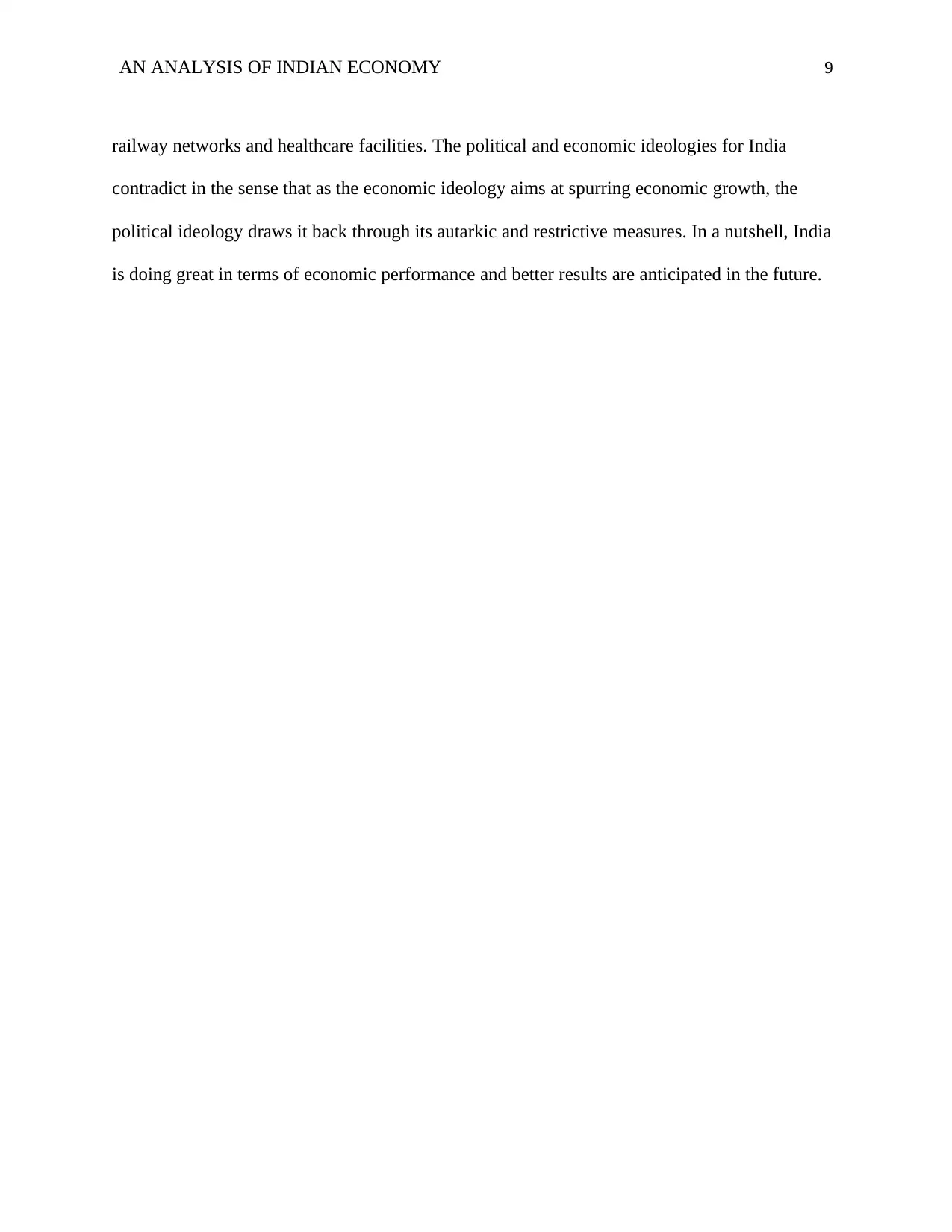
AN ANALYSIS OF INDIAN ECONOMY 9
railway networks and healthcare facilities. The political and economic ideologies for India
contradict in the sense that as the economic ideology aims at spurring economic growth, the
political ideology draws it back through its autarkic and restrictive measures. In a nutshell, India
is doing great in terms of economic performance and better results are anticipated in the future.
railway networks and healthcare facilities. The political and economic ideologies for India
contradict in the sense that as the economic ideology aims at spurring economic growth, the
political ideology draws it back through its autarkic and restrictive measures. In a nutshell, India
is doing great in terms of economic performance and better results are anticipated in the future.
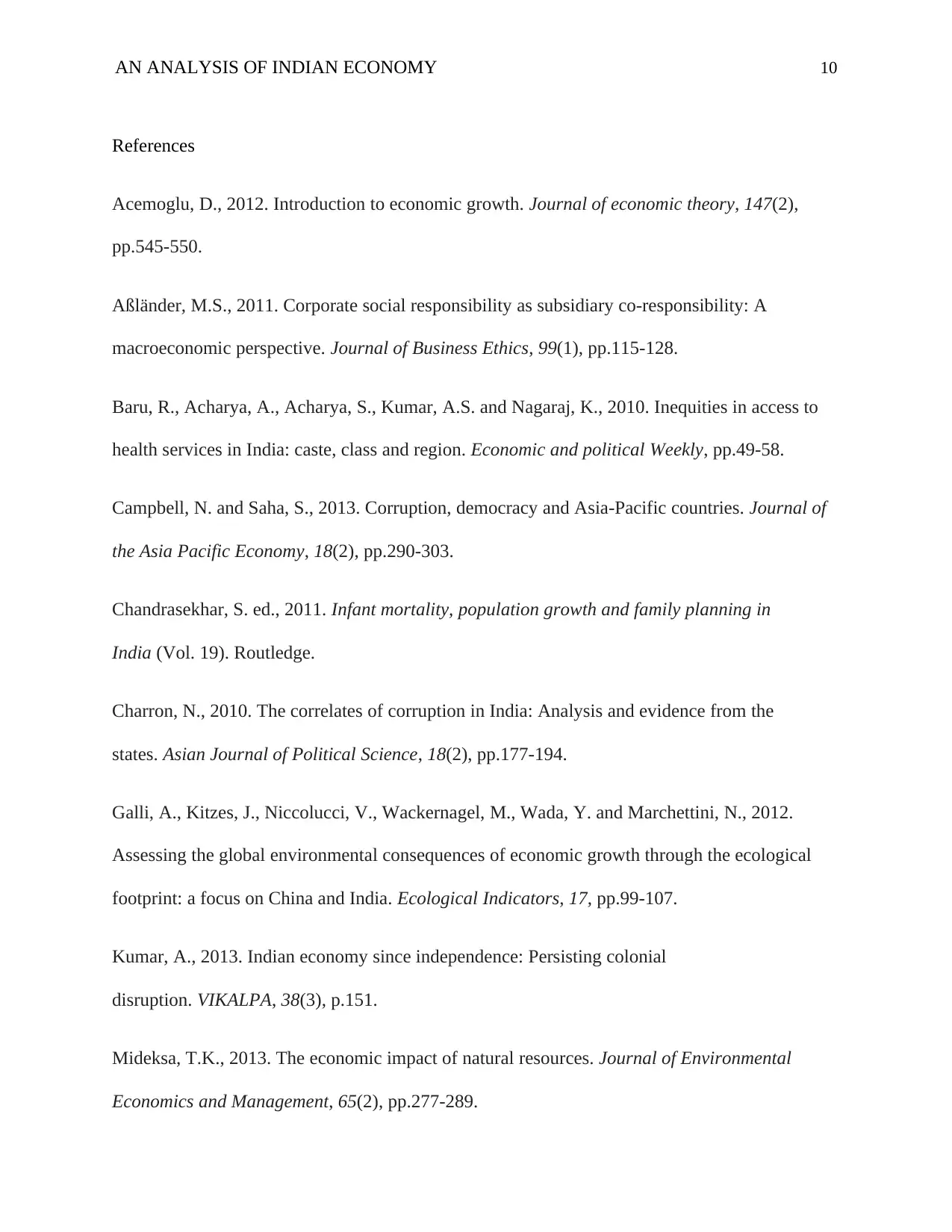
AN ANALYSIS OF INDIAN ECONOMY 10
References
Acemoglu, D., 2012. Introduction to economic growth. Journal of economic theory, 147(2),
pp.545-550.
Aßländer, M.S., 2011. Corporate social responsibility as subsidiary co-responsibility: A
macroeconomic perspective. Journal of Business Ethics, 99(1), pp.115-128.
Baru, R., Acharya, A., Acharya, S., Kumar, A.S. and Nagaraj, K., 2010. Inequities in access to
health services in India: caste, class and region. Economic and political Weekly, pp.49-58.
Campbell, N. and Saha, S., 2013. Corruption, democracy and Asia-Pacific countries. Journal of
the Asia Pacific Economy, 18(2), pp.290-303.
Chandrasekhar, S. ed., 2011. Infant mortality, population growth and family planning in
India (Vol. 19). Routledge.
Charron, N., 2010. The correlates of corruption in India: Analysis and evidence from the
states. Asian Journal of Political Science, 18(2), pp.177-194.
Galli, A., Kitzes, J., Niccolucci, V., Wackernagel, M., Wada, Y. and Marchettini, N., 2012.
Assessing the global environmental consequences of economic growth through the ecological
footprint: a focus on China and India. Ecological Indicators, 17, pp.99-107.
Kumar, A., 2013. Indian economy since independence: Persisting colonial
disruption. VIKALPA, 38(3), p.151.
Mideksa, T.K., 2013. The economic impact of natural resources. Journal of Environmental
Economics and Management, 65(2), pp.277-289.
References
Acemoglu, D., 2012. Introduction to economic growth. Journal of economic theory, 147(2),
pp.545-550.
Aßländer, M.S., 2011. Corporate social responsibility as subsidiary co-responsibility: A
macroeconomic perspective. Journal of Business Ethics, 99(1), pp.115-128.
Baru, R., Acharya, A., Acharya, S., Kumar, A.S. and Nagaraj, K., 2010. Inequities in access to
health services in India: caste, class and region. Economic and political Weekly, pp.49-58.
Campbell, N. and Saha, S., 2013. Corruption, democracy and Asia-Pacific countries. Journal of
the Asia Pacific Economy, 18(2), pp.290-303.
Chandrasekhar, S. ed., 2011. Infant mortality, population growth and family planning in
India (Vol. 19). Routledge.
Charron, N., 2010. The correlates of corruption in India: Analysis and evidence from the
states. Asian Journal of Political Science, 18(2), pp.177-194.
Galli, A., Kitzes, J., Niccolucci, V., Wackernagel, M., Wada, Y. and Marchettini, N., 2012.
Assessing the global environmental consequences of economic growth through the ecological
footprint: a focus on China and India. Ecological Indicators, 17, pp.99-107.
Kumar, A., 2013. Indian economy since independence: Persisting colonial
disruption. VIKALPA, 38(3), p.151.
Mideksa, T.K., 2013. The economic impact of natural resources. Journal of Environmental
Economics and Management, 65(2), pp.277-289.
Paraphrase This Document
Need a fresh take? Get an instant paraphrase of this document with our AI Paraphraser
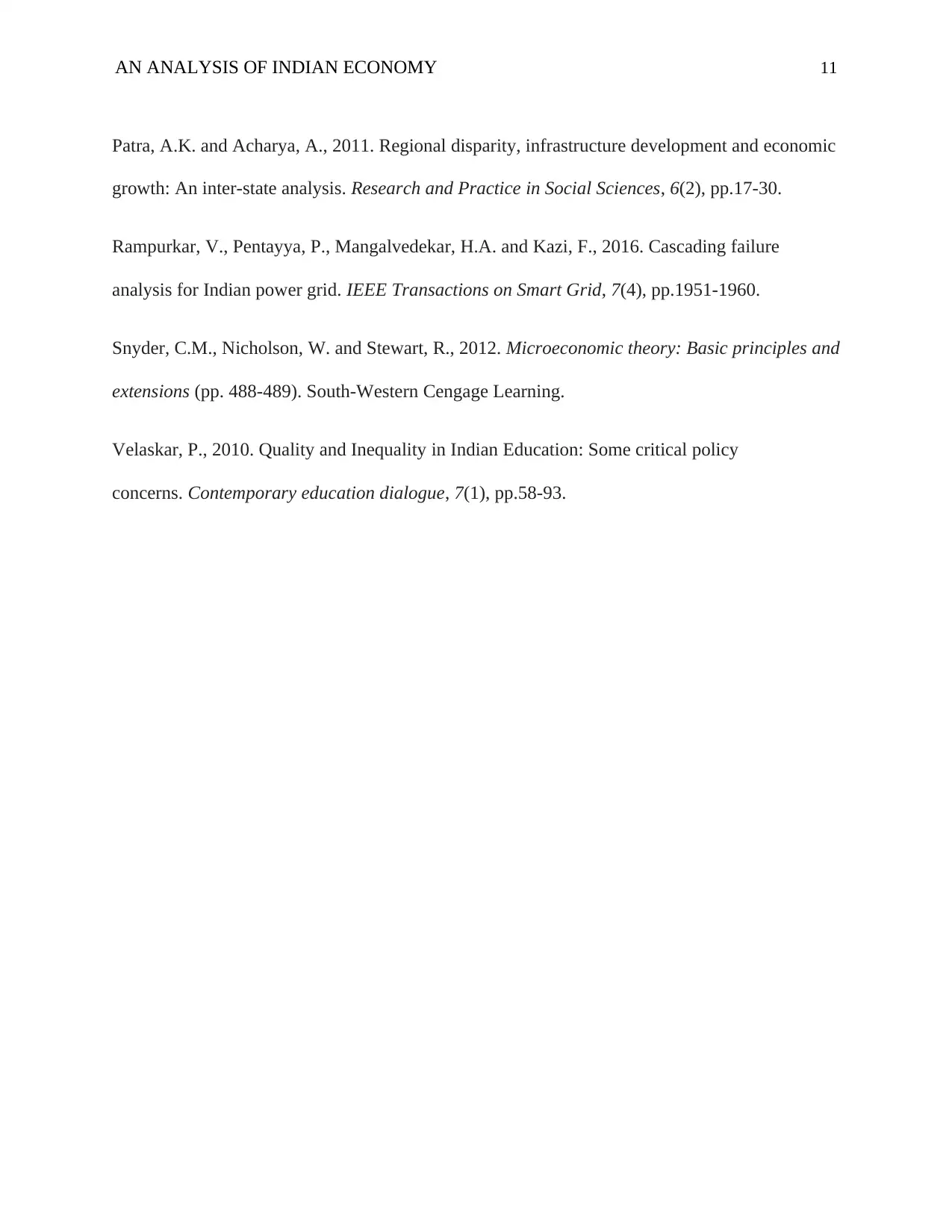
AN ANALYSIS OF INDIAN ECONOMY 11
Patra, A.K. and Acharya, A., 2011. Regional disparity, infrastructure development and economic
growth: An inter-state analysis. Research and Practice in Social Sciences, 6(2), pp.17-30.
Rampurkar, V., Pentayya, P., Mangalvedekar, H.A. and Kazi, F., 2016. Cascading failure
analysis for Indian power grid. IEEE Transactions on Smart Grid, 7(4), pp.1951-1960.
Snyder, C.M., Nicholson, W. and Stewart, R., 2012. Microeconomic theory: Basic principles and
extensions (pp. 488-489). South-Western Cengage Learning.
Velaskar, P., 2010. Quality and Inequality in Indian Education: Some critical policy
concerns. Contemporary education dialogue, 7(1), pp.58-93.
Patra, A.K. and Acharya, A., 2011. Regional disparity, infrastructure development and economic
growth: An inter-state analysis. Research and Practice in Social Sciences, 6(2), pp.17-30.
Rampurkar, V., Pentayya, P., Mangalvedekar, H.A. and Kazi, F., 2016. Cascading failure
analysis for Indian power grid. IEEE Transactions on Smart Grid, 7(4), pp.1951-1960.
Snyder, C.M., Nicholson, W. and Stewart, R., 2012. Microeconomic theory: Basic principles and
extensions (pp. 488-489). South-Western Cengage Learning.
Velaskar, P., 2010. Quality and Inequality in Indian Education: Some critical policy
concerns. Contemporary education dialogue, 7(1), pp.58-93.
1 out of 11
![[object Object]](/_next/static/media/star-bottom.7253800d.svg)





